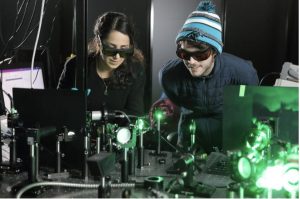Scientists are Bringing Batman’s Freeze-Ray to Life to Cool Electronics
Every Batman fan knows what we’re talking about! But instead of using a freeze ray gun as a weapon, a Professor from the University of Virgina wants to use it to create on-demand surface cooling for electronics inside spacecraft and high-altitude jets.
In pursuing sustainable energy technologies, researchers have embarked on a transformative journey into ultrafast energy transduction mechanisms across diverse material interfaces. The focal point of this groundbreaking exploration lies in understanding the influential role of coupled energy states governing interfacial energy transport. The potential implications of these findings are nothing short of revolutionary, promising to reshape the landscape of energy transfer as we know it.

The challenge: efficiently cooling electronics within spacecraft and high-altitude jets. The solution might involve plasma – the fourth state of matter and common component of stars. Mechanical and aerospace engineering professor Patrick Hopkins and his team at the ExSiTE Lab (Experiments and Simulations in Thermal Engineering) are looking into this possibility, thanks to a $750,000 grant from the U.S. Air Force.
In the close confines of space or the thin atmosphere of high altitudes, regular cooling mechanisms, like natural air or water, become inefficient or impossible. Cooling electronic systems in these environments presents a significant hurdle, particularly due to the limitations of weight and efficiency. The answer, Hopkins believes, may lie in plasma’s unique and somewhat paradoxical properties.
Plasma, which can be generated by energizing gas, releases a flow of photons, ions, and electrons through an initial chemical reaction. Despite reaching temperatures comparable to the sun’s surface, plasma presents a fascinating anomaly: it appears to cool before it heats when making contact with a surface.
This counterintuitive property was uncovered by Hopkins and his colleague, Scott Walton of the U.S. Navy Research Laboratory. Their experiments with a plasma jet and gold-plated surface displayed an initial drop in temperature before a subsequent increase. This phenomenon was attributed to the “evaporation” of an ultrathin surface layer composed of carbon and water molecules, reminiscent of how we feel cool when water evaporates from our skin.
Hopkins’ specialized microscopes capable of rapid, precise temperature measurements revealed that the plasma-induced cooling could reduce temperature by several degrees, albeit for a few microseconds. Even this brief cooling period could prove beneficial for specific electronic devices.
Armed with their new Air Force grant, the team is working on refining their plasma-based cooling mechanism. They are experimenting with different gases, metals, and surface coatings to potentially enhance the cooling effect. The lab is focusing on how the plasma interacts with different material properties and how varying the gas composition impacts the system.
While the journey towards a more efficient cooling solution for high-tech electronics in extreme conditions continues, the team’s work not only presents a potential solution but also adds a fresh chapter to plasma’s role in technology.

